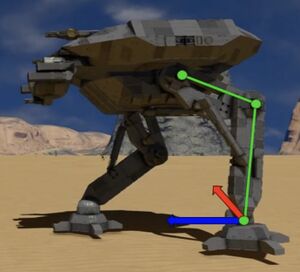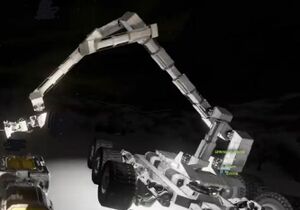Mechanical Blocks
In Space Engineers, the mechanical blocks are Pistons, Rotors, and Hinges. In contrast to other blocks, mechanical blocks can turn or tilt like joints, or they can extend and retract, and they pull attached grids with them.
Video: A beautiful example how to use mechanical blocks by Squeegy Mackoy (2013/2023)
Usage
You use mechanical blocks to build grids with extending drill arms, crane arms, mecha "wings" and walker legs, large foldable hangar doors, collapsible landing legs, vector thrusters, elevators, and so on. You can also use them to keep subgrids statically locked in an angled position for decorative purposes.
To control the movement of mechanical blocks, read about Custom Turret Controllers, Timer Blocks, and the Event Controller.
What Are Subgrids?
The blocks attached by mechanical blocks will appear in different colors in the Control Panel Screen. These attached grids are referred to as subgrids.
This is relevant because subgrids are treated differently as far as steering is concerned: The Inertial Dampers do not consider their mass, and wheels and thrusters on subgrids are not automatically controlled by the WASD keys! Read more about subgrids to understand the pros and cons, and learn about workarounds to fix steering limitations.
What are Hitboxes?
When connected to form subgrids, mechanical blocks can push blocks “into” one another; such physically impossible states generate vibrations that shake the grid apart (also known as Clang).
This is because the physics simulation uses an optimisation where it measures collisions only by looking at simplified collision shapes called hitboxes. Version/1.196 in 2020 decreased oversized hitboxes of blocks and armor to better represent the shape of the blocks, which resolved many old issues, and multiplied the possibilities of smoothly working mechanical constructions.
How to Improve Stability?
In general, it's safest to use the mechanical blocks on static grids, such as your base.
Especially for mobile grids, lock the main grid safely to the ground with ![]() Landing Gear while subgrids (such as drill arms) are moving mechanically, which will temporarily turn the mobile main grid static. If immobilisation is not an option, setting
Landing Gear while subgrids (such as drill arms) are moving mechanically, which will temporarily turn the mobile main grid static. If immobilisation is not an option, setting ![]() Gyroscopes on a zero RPM override helps reduce shaking.
Gyroscopes on a zero RPM override helps reduce shaking.
How Does Sharing Inertia Tensors Stabilise Grids?
The Share Inertia Tensor setting is available only in Experimental mode on PC and consoles. On the Control Panel Screen, enable the Share Inertia Tensor option on a chain of wobbly moving mechanical blocks to stabilise them.
- Only enable this option on mechanical blocks that are attached to other mechanical blocks or non-heavy blocks (e.g. a block tool or block weapon).
- Do not enable Share Inertia Tensor on the one mechanical block that’s directly attached to a heavy or static grid (e.g. a base or spaceship).
Sharing the inertia tensor of a heavy or even static grid will weigh down the whole mechanical construction and render it sluggish or immobile.
This combination of settings equalises the virtual masses of the moving parts to achieve more stable (albeit unrealistic) behaviour of the physics simulation.
How Does Cross Bracing Stabilise Mechanical Grids?
Space Engineers doesn’t care about tensile strength in static grids, but bending and vibrations become noticeable in mobile grids and mechanical blocks. Or, sometimes you struggle with hinges and rotors being to weak to lift heavy subgrids. How to fix this wobbliness?
Stabilise weak Hinges by adding a flexible diagonal support: The most common cross brace is a piston attached by two rotors.
- If you use cross bracing pistons, you must actively extend and retract the pistons to control the movement; and you must make the neighbouring rotors and hinges passive by setting a low braking value, no velocity, and no rotor/hinge lock.
- Do not attempt to actively turn cross-braced hinges and rotors, because pistons are stiff and cannot be pushed or pulled like spring suspensions in real life.


